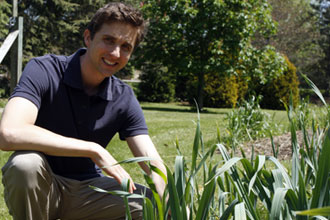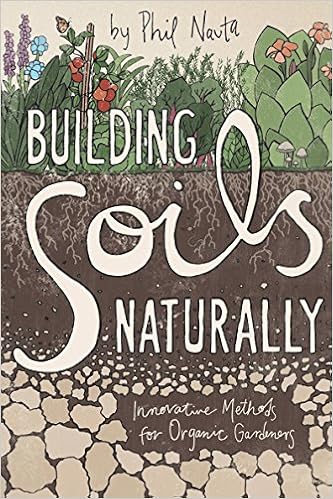I first started reading Phil Nauta and his Smiling Gardener Blog in the fall of 2010. Right away, his blog struck me as different from the other how-to-garden-better blogs.
It was obvious that Phil had a wealth of knowledge. Plus, his info was often quite a bit more “technical” than the others.
To give you a sense of what I mean, Phil regularly wrote about subjects like mycorrhizal fungi, biological transmutation and the brix test.
You’ve got to admit that these topics are not what you’d normally find on blogs like A Way to Garden or Urban Organic Gardener.

Let’s take a sec to get the legal words out of the way. This article may contain affiliate links. That means if you click and buy from my partners, I will make a tiny amount of money at no cost to you. This in no way affects my recommendations.
One Smiling Gardener article that really got my attention was on how gardeners could potentially catch mad cow disease from bone meal. Phil made a strong enough case against bone meal that I decided to stop using it on my flowers.
So when Phil offered a review copy of his newly minted book called Building Soils Naturally, I knew right away that it would be packed with interesting info. It didn’t take much convincing to get me to review it.

Building Soils Naturally from A to Z
Building Soils Naturally starts with the basics of improving your soil. Some of these areas he also wrote about in his Suburban Hobby Farmer guest article.
Then it progresses to the deeply technical aspects of determining and curing specific soil nutrient deficiencies.
A fruit or vegetable grown in ideal soil conditions will be no less than a super food.
— Phil Nauta
Much of the information could only come from someone who has studied plant nutrition in some detail. There’s no question Phil has studied.
He started a natural fertilizer company and has taught organic horticulture at Gaia College, a school that teaches holistic land management and environmentally sustainable technologies.
There’s also no question that he’s doesn’t use standard NPK (nitrogen, phosphorus, potassium) fertilizer. Nauta challenges the proponents of NPK whenever he has the opportunity.
Related: Cover Crop in the Vegetable Garden
His book encourages readers to go beyond even organic soil improvement methods with soil tests and unusual (even exotic) additives.
Unquestionably, parts of Building Soils Naturally will be more sophisticated than what many backyard gardeners will be willing to put into practice.
Be warned, Phil frequently suggests seeking out and paying for soil additives. Regular readers of this site know that this goes against the spirit of Suburban Hobby Farmer, where I try to pay as little as possible for my soil improvement.
Paying will be worth it
Phil promises that paying for soil amendments will be worth it. He believes that once you reach the perfect soil for a specific plant, it will be invisible to insect predators and diseases.
Produce will be tastier and much more nutritious. Plus, the shelf life will be greatly extended. In short, a fruit or vegetable grown in ideal soil conditions will be no less than a super food.
Phil is skilled at persuasion. He makes a great case for his methodology.
Still, some claims seem too good to be true. Take Phil’s point that plants grown in ideal soil will be invisible to predators.
This has not always been the case in my garden. My blueberries have nearly ideal conditions, including soil that is perfect for them.
Yet, Japanese beetles are able to locate them and prefer them over other crops that have been weakened by less than ideal soil. My philosophy is nothing works 100 percent of the time.
Still, this book has more new ideas than anything I’ve read in a long time. There are many suggestions that I want to test in my garden. Here are five examples:
1. Water your soil microbes, not just your plants. Many gardeners, myself included, have been guilty of watering only in the root zone of my vegetable plants. I thought this was a good way to save water.
The problem with pinpoint watering is that the soil life outside of the wet zone is deprived of water. Microorganisms, earthworms and insects need water as much as the plants.
The health of your plants depends on the health of these organisms.
2. Add seaweed to your compost. I’ve been thinking that seaweed would be a nutrient-rich, free source of material for the compost.
Related: Pick Your Own Seaweed Fertilizer for Your Garden. Your Plants will Love It!
This book gave me the kick in the pants to go get some. According to Phil, there’s no need to rinse the salt out before adding it to the pile.
3. Try diluted sea water as plant food. This is one of the most controversial ideas in the book.
The premise is that sea water has minerals and active organic substances that will benefit your plants.
Phil points to research by Maynard Murray that concluded that minerals from sea water increased yields and improved the overall health of plants.
As you might expect, others believe that essentially “salting” your soil is a bad idea. I’m going to test a 10 percent solution of sea water on a small part of my garden. I’ll let you know if it works for me.
4. Add hairy vetch as part of your cover crop. Phil makes the case that cover crop should be a mixture of legumes and grasses. Legumes add nitrogen to the soil and grasses provide high volumes of organic matter.
He likes hairy vetch as a legume because it captures the most nitrogen. He likes cereal rye as a grass because of the volume of organic matter it provides. I’m going to try a combination of the two this fall.

How to Improve Soil
All the ways I know to improve your soil.
5. Inoculate your compost with new microbes. One way to get some diversity of microbes in your compost is to take a few handfuls of soil from an ecosystem that’s different from your garden, say a forest or a meadow, and add it to your pile.
This will help create microbe diversity in your pile and ultimately your soil, which will help make for healthier plants.
There are many more interesting ideas about how to improve soil health in Building Soils Naturally. Most of these involve more expensive and often hard to find ingredients.
Professional landscapers (organic) will be very interested in Phil’s suggestions because they must get superior results and often have a budget for buying soil amendments.
On the other hand, I’ve always felt that it doesn’t make sense to spend more on your garden than it would to buy organic produce. Of course, it’s tempting to invest in some of these ingredients when the benefit is ultra nutritious food.
Related articles you might enjoy:
Suburban Hobby Farmer is a participant in the Amazon Services LLC Associates Program, an affiliate advertising program designed to provide a means for sites to earn advertising fees by advertising and linking to amazon.com.